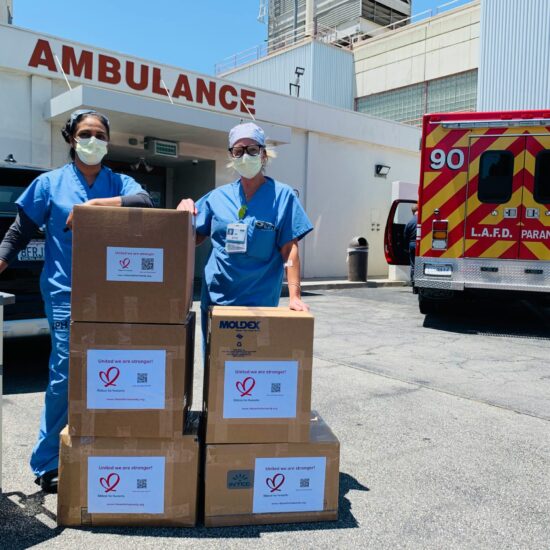
A category five typhoon hits the coastal city of Tachloban in the Philippine Islands. Somewhere in the city, a young girl and her family manage to survive the three tsunami waves, and the high velocity winds that claim the lives of approximately 22,000 people. The year is 2013.
Two years later, this same girl comes to a local international-aid health care clinic for evaluation. She is emaciated, likely due to her inability to eat. Her lack of nutrition isn’t because of lack of food, as one might suspect in a country recovering from natural disaster; eating isn’t possible because of a large mass protruding both from her mouth and bulging out of her neck. She knows something is wrong, and her parents know something is wrong; yet they lack the health literacy skills and resources to advocate for further care.

Real life childhood cancer superheroes! Powerful Patrick and Resilient Rina Sy. Photo courtesy of Stacy Bostrom.
My heart sank when I first saw this child walk in the door of our pediatric clinics during my recent health care mission trip to Tachloban City. Her mass was impossible to miss. So was her parent’s worry over her growing inability to swallow, and her increasingly difficult breathing. Her city was still struggling to put the pieces back together from their typhoon afflicted community, and her family consists of survivors, but they were acutely aware that something additional was wrong. Despite our language barrier, I could feel both the intensity, and the desperation, of their need to understand.
Her parents pulled out a piece of paper that seemed to be results from a local hospital. The crinkled form showed that abnormal cells were present in their daughter’s blood, but that she needed a biopsy for further clarification. “Is a biopsy a cure? Where can we get one? How much does a biopsy cost? How do we get there if we have to work all day to keep food on the table?” I didn’t need to understand their words to feel their concern.
In the clinic, we worked with the translators to sift through the medical jargon into lingo that is understandable to all. Through one of our volunteers, I listened to the child and her parents, then told them, “A biopsy involves collecting tissue from the tumor that will help to determine the diagnosis. Once the diagnosis is determined, a treatment plan can be created. We can’t know if she will survive without knowing what this is. “
There I was, a pediatric nurse practitioner in a make-shift clinic, in a third world country, in a community with minimal resources recovering from a heinous natural disaster, faced with a child who most obviously had cancer. My gut and my training told me it was cancer, while my soul pondered the injustice of this child’s geographic and life lottery.
Our team was graced with two phenomenal Filipino physicians, Drs. Loida and Mary Del Rosario; a dedicated local social worker named Aaron Polidario; and many other generous advocates. Together, we performed a biopsy on the young girl’s abnormal tissue; it revealed rhabdomyosarcoma.
Despite concentrated and long-term efforts, I learned that this precious girl passed away a few weeks ago. She survived a typhoon that killed over 22,000 people, only to be killed by cancer two years later. Her face will remain with me forever – one among many that I couldn’t help save.

Training for the San Diego International Triathalon with Team in Training: Kristi Westphaln, Marianne Sy, and Keith Sy. Photo courtesy of Kristi Westphaln.
Childhood cancers continue to claim pediatric lives across the world every day. Every three minutes, a family in the world is receiving the news that their beloved child has cancer. But how is childhood cancer dealt with in the third world? The answer is simple – unless they receive treatment, these children will die.
September was Childhood Cancer Awareness Month – I share this story not to sadden, but to empower. As kids develop different cancers than adults do, additional research funding and efforts are needed to address this vulnerable population specifically. Global outreach is especially needed – two children with similar cancers in opposite geographic locations may have different outcomes because of a host of site-specific variables: poor access to care, lack of primary care, low income, low health literacy, and even distance and transportation barriers to receive treatments.
Dare to care? There’s no shame in wearing gold all year, the color of childhood cancer awareness. Step up and tune in to HealthCetera Radio today, at 1PM on WBAI-NYC 99.5FM, for a special Tale from the Cribs dedicated to Childhood Cancer Awareness, or online via their archives here. The show features an overview on pediatric oncology, an interview with the super-star Sy family sharing their intimate experiences in conquering leukemia, and tips on how to get involved.








